
Simon Stalks Plants
2. Stalking the Panama Hat Plant
|
The hunt begins. It is early morning in coastal Ecuador. There are six of us. We are out to bag cogollos. The most sought-after cogollos in the world. |
|
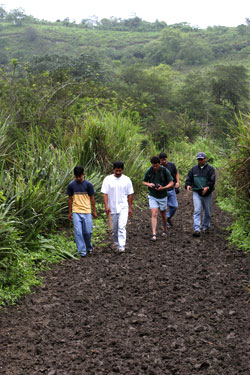
Left to right: Carlos, Simón’s son. Simón, the best hat weaver on the planet. Roff Smith, travel writer of renown. Diego. Jorge. |
We will hike into the equatorial rain forest, to a specific valley with a very special microclimate. For more than a century, this tiny spot on the planet has been home to the world’s most coveted cogollos, from which are woven the very finest Montecristi Panama hats. The hats that give proof to the legends of cloth-like fineness, the hats that inspire the bar bets, the hats that sell for tens of thousands of dollars to people you wish you knew. Cogollos are the unopened, central leaf spikes of the Panama hat plant, aka Carludovica palmata. Master Weaver Simón Espinal is our guide. He is the best Panama hat weaver in the world, possibly the best in history. He has been making this trek several times each year for the past twenty-five years, since he was fifteen. Simón’s father made the same trip, beginning when he was a boy. And his father before him. Simón’s son, Carlos, is with us. Simón had called the owner of the land two days before to get permission for us to hike in and hunt cogollos. The owner was supposed to come with us but he called in lazy that day. Smart man. |
|
The trail begins as a wide, muddy cow path through a pasture. It turns into a narrow, muddy sliding board through a rain forest, complete with howler monkeys, exotic butterflies, jungle birds, lethal biting things behind every leaf and root, malaria in the air, invisible weightless insects that bite you and five years to the day later you drop dead. We all saw the monkeys, butterflies, and birds. The hike to reach the plants was two and a half hours of slip-and-slide climbing, uphill, in ankle-deep mud clingy as a baby with a monster in the room. Lifting my foot was a pulling contest. Putting it back down was a potential Olympic thrill event. One particular miscalculation sent my right foot on a mud skiing race while my left foot stayed mired in the muck. I hurtled face first into a thorny cattle hedge while simultaneously trying to split the crotch seam of my pants, and the crotch seam of me. Not as enjoyable as it might sound to the uninitiated. A second bit of footloose folly a half hour later and I was airborne, ankles over elbows, hoping I would become twenty years younger before I landed. I didn’t. I hit with a wet squoosh followed instantly by a tooth-loosening thud. Together, they produced a rubber-stamp imprint of my posterior portions as a warning to others to step carefully. At one point, Simón commented, without any intended irony, “It’s good we came today. Sometimes it’s bad.” Maine humor in Ecuador. (Two years later, we hiked in on one of Simón’s bad days. We had to bring donkeys to carry the video cameras. Seriously.) |
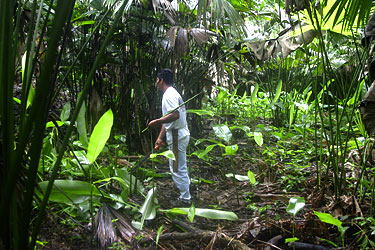
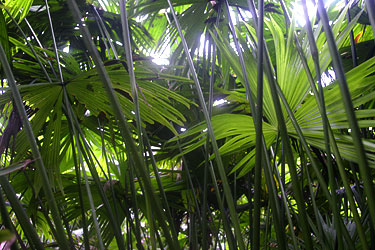
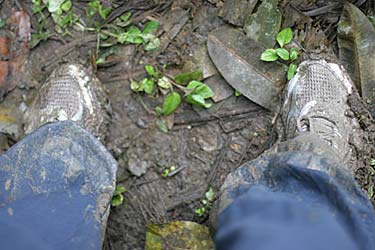
|
|
No one had warned me that the trail was uphill all the way from the road to the Panama hat plants. Doesn’t seem right to hike uphill to a valley. Curiously, it was uphill all the way back too. Just as I was beginning to wonder if we were still in Ecuador, Simón announced our destination was a hundred meters ahead. The plants from which Panama hats are made are Carludovica palmata. The scientific classification of the plant was made in the 18th century by two Spanish botanists. The name is a contraction of Carlos (Carlos IV, King of Spain), and Ludovica, Latin for Louisa (wife of Carlos IV). Basically, the botanists were sucking up to the boss. The grove of Panama Hat Plants “near” Simón’s village is quiet, damp (rain forests are often damp), home to a million hungry mosquitoes with Gringo on the menu. It is relatively open amidst the plants, looking tended, almost managed. |
|
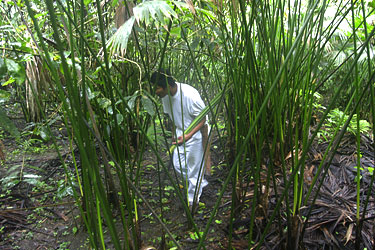
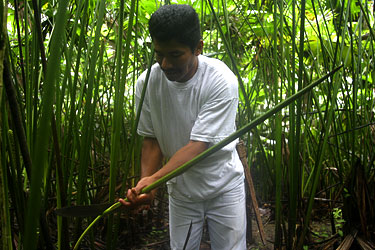
|
The plants are taller than we are, arcing to ten or twelve feet. Each plant is a cluster of tall, thumb-thick, celery-shaped stalks topped by oblong, poorly-made, palm-ish leaves a yard wide. All very green. An irresistible habitat for spiders genetically commanded by millions of years of evolution to weave their webs at precise angles to the light in order to make them perfectly invisible to faces moving at exactly my height. Imagine a suburban white man shrieking and dancing in the jungle, clawing at his face, believing death is near. Many times. Simón searches through the grove of plants, looking for cogollos that are the right age and plumpness. He squeezes some of the cogollos he judges to be ready, a final feel test. Others he judges solely by sight. Left alone, cogollos will grow larger and shed their outer leaf casings to become new fronds of the plants. Simón rejects some that are too young, saying they will be ready in another week or two. Others are past their prime, too large, the leaf shoots inside already a little too tough to be used in the very finest hats. Simón chooses carefully. He moves rapidly, confidently, hard to keep up with. His judgments come quickly, unhesitatingly. Yes. No. 1. 0. He pauses only for the camera, smart, an instinctively good model. Choose, hold, cut, hold, move on. |
|
He will need at least 48 cogollos to weave a hat. Often more, if the yield of perfect straw is low in some of the cogollos. Today, he will harvest between one dozen and two dozen cogollos, enough to keep him weaving for six to eight weeks. |
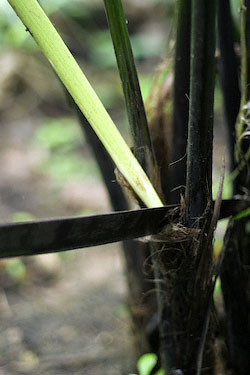
|

|
|
I love it. I’m slogging through a South American rain forest, juggling cameras, swatting at mosquitoes, trying not to slip and die, trying harder to keep up with the best weaver in the world as he cuts the plants to make the straw to make the miracles. I am at the source of my Nile. These cogollos that Simón cuts today will be turned into straw that will be woven into a hat beyond belief, a work of art. |
 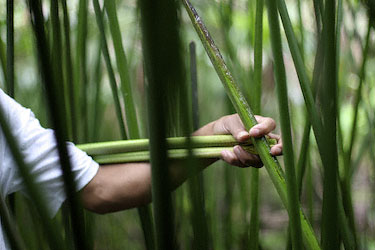
|
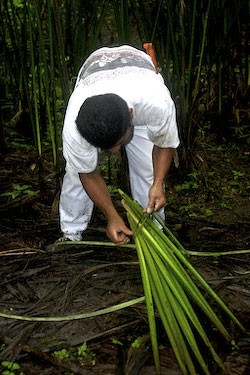 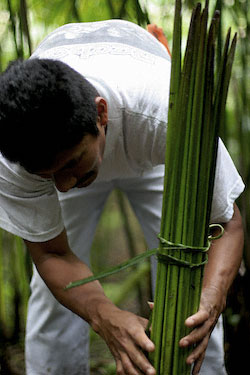
|
When Simón has harvested enough cogollos for the weaving ahead, he gathers them up, bundles them, binds them with fibers cut from the stalk of a mature frond. |
|
He makes a strap, shoulders his bundle, and he’s ready to go back. Me too. The mosquitoes are disappointed that I’m leaving. I hear them whining all around me. See Simón tame his wild cogollos. NEXT PAGE |
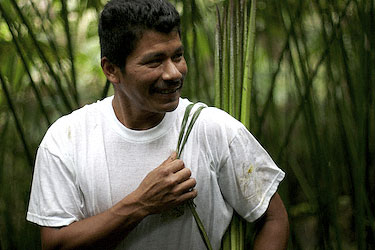
|
3. Preparing the Straw go to
Text and photos © 1988-2025, B. Brent Black. All rights reserved.
100% Secure Shopping



















































